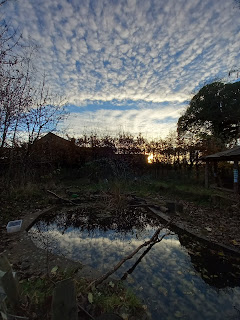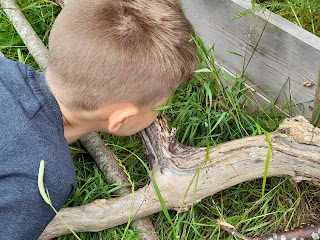Moving Forward
Forest School is just one aspect of Outdoor Learning, but it's the one I lead so I write about it often. The development of other outdoor focuses rests on the school as a whole and although I participate I can't always explain them well if I haven't been involved.
There are lots of possible routes for learning outside, from literally taking a class based lesson out onto the grass, to working with the landscape available and creating learning specific to whatever environment you have nearby.
So a class reading session in the playground, clipboards to draw a local tree, or a walk around the local area counting cars/houses, looking at architecture, learning a route, spotting wildlife etc.
Whatever your school has available, urban or rural, can be woven into daily teaching. For us, with a lot of outdoor space, it's a huge waste of resources NOT to.
A recent chat on Twitter reminded me about Te Whariki, the New Zealand Curriculum for Early Childhood. When I first read it's 1996 form the first thing that struck me was how it centred learning around the processes of learning and not the subjects
"Te Whāriki is underpinned by a vision for children who are competent and confident learners and communicators, healthy in mind, body and spirit, secure in their sense of belonging and in the knowledge that they make a valued contribution to society."
Compare that with the EYFS:
"The early years foundation stage (EYFS) sets standards for the learning, development and care of your child from birth to 5 years old."
And it's easy to see how children's learning has been detoured into gauging knowledge and proving teaching... There is a constant battle in Early Years to wrench back child centred learning but it shouldn't be the sole domain of Under Fives.
As adults there is usually one or two 'subjects' that we know an awful lot about. It might be job related, it might be from local history or an author, it might be a hobby, from knitting to birdwatching, it might be a lifelong battle with secondhand cars that leads to an intimate knowledge of how to remove a dashboard....
Whatever drew you to the subject you feel you could give lectures on, you will have learned more about it since leaving education than you ever did at school - if in fact you ever learned anything about it at school at all. Tapping into that enthusiasm is something schools often struggle with because the system prescribes the facts that they have to impart. There are innovative ways to do this but time, space, and budget place further restrictions.
However, most children are passionate about being outside. Whether to run or climb trees, to jump in puddles or find bugs, whether to enjoy the peace of the great outdoors alone or join friends in exploring, outdoor spaces alter the way a child learns. There's a chance to harness that interest and use it.
Outside you can use a mud patch to dig for fossils (actual fossils, reproductions or class made),
you can measure and mark out the actual size of some of the creatures,
you can make a timeline to scale,
you can plant things they may have liked to eat,
you can decide what would have lived in an environment like your sandbox, playground, school garden, sports field, local park etc.
You can photograph toy dinosaurs in said habitat and make a story, or a fact sheet...
story writing,
fact finding,
history,
geography,
problem solving,
research,
data handling,
teamwork,
collaboration,
exploration,
and so much
more, in a more meaningful way.
And you just differentiate the outcomes from Year R seeing size and scale tangibly, to Year 6 measuring it, predicting it, and creating data for height, length, mass and weight.
Outdoor Learning lends itself to the Te Whariki principles of empowerment, holistic development, community and relationships easily.
"We're doing Dinosaurs, can you do an activity to support it...?"
This can take away from what Forest School is all about, which is child led activities and a range of transferable learning skills.
It can also stunt the myriad of directions such exploration opens up if such theme-specific outdoor learning is confined to a time when the teacher in charge of the topic isn't present. Outdoor learning needs to integrate with indoor learning to be truly effective.
Forest School also has it's own progression of skills to follow that may not fit in with a topic on Victorians!
I am aware that an independent Forest School with all day sessions frequently take on a theme, it's a good way to introduce some of the skills FS brings. For children who may well be in that environment daily there may need to be changing focuses to ensure all children access the learning in different ways.
For a school with a class getting outside once a week with the Forest School Leader there needs to be a separation of playtime, Forest School Sessions, and Guided Outdoor Learning. Constantly expecting Forest School to supply outdoor activities to support indoor work can be a poor use of a trained Forest School Leader.
Ensuring all staff engaged with playtime development, FS and delivering an Outdoor Curriculum are working together is how you make the most of the collective expertise and communication, and maximise every kind of outdoor learning available.
Looking back on this little blog I guess we've come a long way since September 2019, especially considering the covid interruption! Somehow it feels like we've barely touched the surface!
There still are so many ideas swirling around, mine and other people's, that it's hard to pick one and go with it. I will always be split between Forest School planning/implementing, and site development no matter what, then I'm also available to help thrash out ideas from others, and to take cues from the children, and to see what volunteers have to offer, and to make local links, and to see what will improve the school site and Outdoor Learning....
There are solid plans on paper, things in development, and pie-in-the-sky wishes, like the beautiful wooden door picture further up on the page, built by David North, called 'Doorway to Imagination' that I'd love to see INSIDE a school as a door to a library... (click the photo for an article)
Getting me started on how to bring the OUTSIDE inside is a whole new topic! You can't blur the lines between inside and out while there is a definitive line between the two.
But that will have to be another discussion!










Comments
Post a Comment